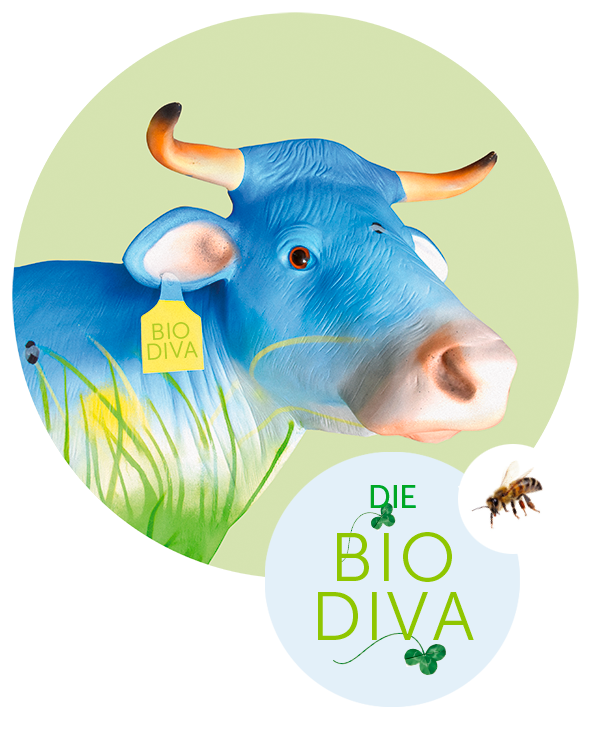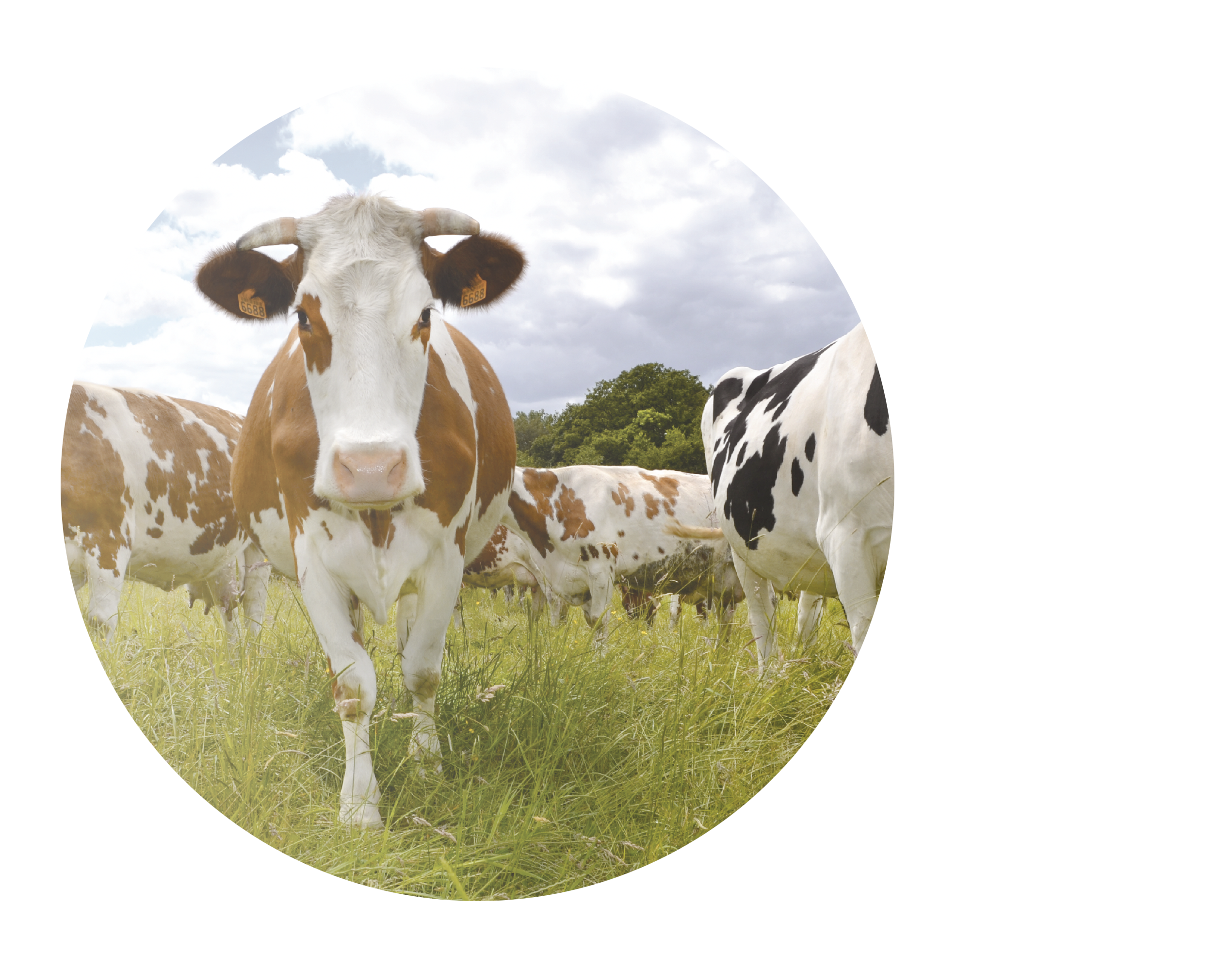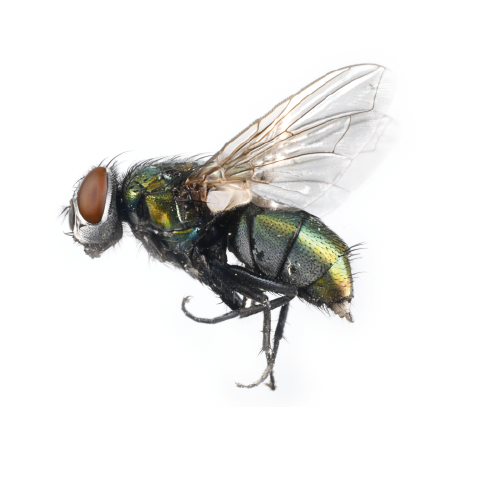
FOR A NEW AGRICULTURE
Our main concern as Oikopolis Group is agriculture. All the companies within this group are involved in agriculture and food processing. Their engagement in sustainable agriculture is a response on the crisis in agriculture, already perceived decades ago by some individuals who started to change agriculture at that time. As farmers, they realised that against the generally prevailing opinion, agriculture evaluated according to economic criteria only, like any industrial production company, is wrong. For decades, young farmers were advised to invest in size alone: more land, more animals, the latest machinery, bigger tractors... with the aim of increasing yields. The maxim was "growth or give way".
Where do we stand in agriculture today with this advice from back then? The necessity for a change in the way we produce our food and cultivate in agriculture is greater than ever. It is gratifying that this is increasingly realised in society. It is becoming obvious that the prevailing view on agriculture and its development does no justice to the current crises (climate crisis, food crisis, loss of biodiversity...) It does not help to solve the problems, but rather exacerbates them. Therefore, there is an ongoing widespread discussion on how to shape the transformation of the agricultural sector towards long-term sustainability. It is clear that individuals only cannot solve those crises. However, individuals can provide their ideas and can set examples. Real transformation and change will only happen when people set off together and agree upon common goals.
Politicians - as a reflection of society - are also making efforts to advance the transformation, e.g. through adjustments in subsidy policy and by setting new targets. In the Luxembourg government programme, for example, the goal to expand organically farmed areas to 20 % of the total agricultural area by 2025 has been formulated. 100 % organic farming has to be achieved by 2050.
However, new targets are not enough. All stakeholders must be shown options and ways, as well as given assistance in order to achieve the goals set.
From the start, engagement of the Oikopolis Group for a new agriculture focuses on a socio-ecological alternative to the mainstream agricultural scenario. Ecologically through sustainable farming without toxic substances and artificial fertilisers. Socially through self-organisation of farmers in a cooperative, that has developed its own processing and distribution channels downstream.

THE COW’S ROLL IN AGRICULTURE
Cattle keeping (and therewith the cow) reflects the situation of the agricultural sector. Agriculture has become disconnected from people’s daily life and farms and farming have become marginal phenomena. Besides, food producers are suffering as they are partly observed as culprits of the crisis.
Thus, cows are repeatedly the centre of the current discussion about the climate crisis. They are blamed for their methane emissions that occur during digestion. Is the cow really a climate killer? If one really wants to assess the role of the cow, it is necessary to take a broader view and not just look at one aspect.

THE COW AND THE CULTURE
Without the taming of wild cattle (aurochs) into domestic animals, our culture, our way of living would not have developed in the same manner. Keeping the cow as a domestic animal enabled humans in Europe to settle down over 8,000 years ago. From being hunter-gatherers, men became farmers, actively influencing nature and thus creating culture.
This kind of agri-culture with the help of domesticated wild animals ultimately made human development possible over thousands of years and created an incredible diversity of life in landscape, flora and fauna through the alternation of forest and pasture areas. This biodiversity has been the basis of human development for thousands of years. The cow, and with it the goat and the sheep, have made a significant contribution to this. As ruminants, these animals, like buffalo, deer and antelope, have a special digestive system adapted to their plant diet: in addition to the normal stomach (abomasum), they have several forestomaches (rumen, reticulum and leaf stomach). This enables the cow to transform grass into food (milk, meat) for humans.
According to the Food and Agriculture Organisation (FAO) about 70 % of the total agricultural land worldwide is pastureland, which is only suitable for grazing by ruminants.
The real miracle, however, is that the cow improves soil quality through its manure. This is what cattle and their conspecifics do in many parts of the world. However, unfortunately, their ability is also often misused. For example, the focus often lies on the amount of milk and meat produced. Cows are supposed to "produce" as much milk and meat as possible. However, quality aspects of these food products, as well as animal welfare or the vital contribution to soil fertility and biodiversity are disregarded.

THE COW AND THE SOIL
The importance of the cow for healthy soil life is often misunderstood. Yet it is their activity, eating, digesting grass, clover and herbs and excreting manure, through which they significantly and sustainably promote soil fertility.
Through grazing, the cow triggers a growth impulse in the grass and thus CO2 absorption through photosynthesis. As a result, the biomass both above the surface and underground increases. The latter expands in the form of roots and thus binds CO2 from the air.
Did you know that sustainable pasture management actually binds more CO2 in the soil than forest soil does? Grassland stores up to 50 % more carbon compared to forests. This potential of sustainable grazing is hardly recognised by climate activists.
In addition, the manure excreted by the cow affects soil fertility. Each cow leaves behind more than 10 tonnes of manure per year. This provides a livelihood for a large number of insects before it is "processed" into humus by earthworms and other (micro-) organisms along with decaying plant components. The grass roots thus become tomorrow's humus, more than half of which consists of carbon. Thus, each additional tonne of humus in the soil relieves the atmosphere of 1.8 tonnes of carbon dioxide (CO2).

Did you know that artificial fertilisers used in conventional agriculture are largely produced abroad, partly in Russia, using a lot of energy. Even if agricultural products are grown and produced regionally, artificial fertilisers produced in faraway countries are used for fertilisation. If such production chains are disrupted by political or even warlike influences, the high dependence of regional conventional agriculture becomes clear.
In contrast, organic farming relies on internal cycles in the farm organism. Legumes (e.g. clover, lucerne, peas, lupines, etc.) play an important role in crop rotation.
Legumes have two important functions for organic farming: on the one hand, they have the ability to bind nitrogen from the air with their nodule bacteria on the roots and to store it in the soil. This naturally bound nitrogen provides nutrients to the grass or other crops, e.g. cereals. Artificial nitrogen fertilisation, which is common in conventional agriculture, is therefore not necessary in organic farming.
On the other hand, legumes are valuable fodder for the cattle, which produces milk and manure from them. That way, cycle-oriented organic farming is able to produce its fertiliser autonomously, in the natural cycle directly on its own farm, without dependence on global economic distortions. This strengthens the independence of the organic farmer and ensures regional food security.
Zum anderen sind die Leguminosen wertvolles Futter für die Kuh, die daraus Milch und wiederum Dung produziert. So ist die kreislauforientierte Bio-Landwirtschaft in der Lage, ihren Dünger autonom, ohne Abhängigkeiten von weltwirtschaftlichen Verwerfungen, im Naturkreislauf direkt auf dem eigenen Hof zu erzeugen. Dies stärkt die Unabhängigkeit des Bio-Landwirts und sichert die regionale Ernährungssicherheit.

THE COW AND BIODIVERSITY
There is not only a significantly greater diversity of soil organisms due to pasture farming, also the diversity of plants is visibly greater on organic pasture than on a meadow which is "doped" with artificial fertiliser. The latter ensures that only certain plants prevail and that the diversity of herbs, which is important for the health of the cows, decreases significantly. The diversity of plants is closely linked to the diversity of insects and even birds. Dairy farming and the cow thus make an important contribution to biodiversity and hence to the stability of our ecosystems. There is a clear difference between organic and conventional dairy farming.

THE COWPAT AS A BASIS FOR BIODIVERSITY
The cowpat is the staple food of biodiversity. It is virtually an island of life with its breeding grounds for insects, which in turn are food for birds. Scientists have counted over 4,000 insects in a single three-day-old cowpat. In purely mathematical terms, a cow that produces ten tonnes of cow dung a year on the pasture thus produces more than 100 kg of insects and thus also the basis of life for a large number of birds.

THE COW AND THE QUALITY OF LIFE
Finally, the way the cattle is kept significantly influences the quality of the food the cow produces. It makes a difference whether the cow spends a lot of time on pasture, feeds on diverse grasses and is treated respectfully. Whether its performance is measured primarily according to industrial criteria. The results of various studies proof this.

A NEW RELATIONSHIP WITH COWS AND AGRICULTURE
If we continue to see the cow primarily as a meat and milk producer, fed with arable feed such as maize and soya from South America, she will have no future, as her role is seen as a contributor to the climate crisis. Until then, the cow will continue to be exploited and forced into husbandry conditions that are increasingly perceived as ethically unacceptable by customers and which will therefore ensure its demise. Without the cow's contribution, without her accompaniment to humans over thousands of years, the cultural development of humankind would simply not have been possible.
What do we need instead? We need to change our view of the cow and realise that she has incredible potential for solving not all, but many crisis. Her task as a companion for people is not over yet. In order to realise this, it is helpful that we reflect on the cows so-called core competencies. What is she best at, where is she unbeatable?
- The cow is able to turn grass into food.
- The cow produces natural fertiliser and thus promotes life and fertility in the soil.
- The cow improves demonstrably the biodiversity of plants and herbs.
- Grazing not only increases the diversity of plants and herbs, but also the variety and number of soil organisms.
- As a direct consequence, the number and diversity of insects increases, which in turn is related to birdlife.
- The biodiversity of the flora enables the diversity of the fauna.
- The insects (bees) are in turn essential for the fertilisation and diversity of the plant world.
It becomes clear that the cow is much more than just a meat and milk producer. Her main role (and "core competence") is her contribution to biodiversity. With her activity on the pasture, she almost magically connects life on the ground - even with the flying insects and birds – as with life underground. She plays a central role and without her, biodiversity, the diversity of flora and fauna, would simply collapse. However, biodiversity is the basis of all our agriculture and thus also of our food. As stated, the interaction of animals and plants, made our human development possible in the first place and on which we continue to depend.

THE APPRECIATION OF THE COW
For thousands of years, the cow has accompanied humans in their development and enabled humans to live in many areas. Not only has she directly provided humans with food (milk, meat) and been useful as a draught animal in agriculture, but she has also shaped our natural basis of life in many ways. Her interconnected impact on the natural world is almost impossible to comprehend. Earlier generations still experienced and felt this fact through living directly with the cattle. Each individual cow was important and even sacred, as it still is in some cultures today. In the annual cycle of nature, the cow had an inestimable value for the largely rural human society.
From there, we have mutated into an industrial and then to today’s service society. New principles developed like “think and act globally” based upon the global labour division. Agriculture became subordinated to those principles.
Also quietly and secretly, short-term monetary goals have become the general maxim of economic activity, even in agriculture. Thus, the long-term (sustainable) effect of agriculture as part of the natural cycle was lost from the consciousness of modern man.
This is where we as OIKOPOLIS Group started and are trying to restore the connections that have been lost from view. Currently the Oikopolis Group evaluated he overall performance of the eleven organic milk producers of the BioG cooperative with the help of a new method developed by Christian Hiß, called the regional value performance calculation. After a comprehensive data collection, the long-term impacts of the dairy farms on e.g. soil fertility, climate, groundwater and biodiversity were assessed. The method makes it possible to define the performance of a farm by not only comparing inputs and outputs in the short term, but also to include the long-term effects on nature and culture in order to obtain an honest picture. By determining comparable key figures, the method shows the individual farmers where improvements are still possible or necessary.
THE COW - OUR “BIO-DIVA”
Looking at agriculture with the help of Christian Hiß's new evaluation method enables us a new respect for the cow's performance in our modern society. With her capabilities, she is not only a methane separator and milk and meat producer, but she can also be part of the solution to many crises. However, here also, it is necessary to look at the whole picture, i.e. at interrelationships and processes. The cow's best impact in terms of sustainability is in organic farming, where she plays a major role in the cycle of the farm organism.
The cow deserves our full attention. She is a star of agriculture, the centre of attention in every stable, well connected, sometimes stubborn, nervous and unapproachable, but always sovereign. Reliably and selflessly, she has been performing her services in nature and culture as a companion to humans for thousands of years, right up to the present day. If you look at all her abilities and achievements, you also recognise her beauty, which makes her a true “Bio-Diva” for us.
Paul Bedel, a late farmer from Normandy, expressed his appreciation to the cow in his book of the same title:
"My cows are pretty because they eat flowers."
